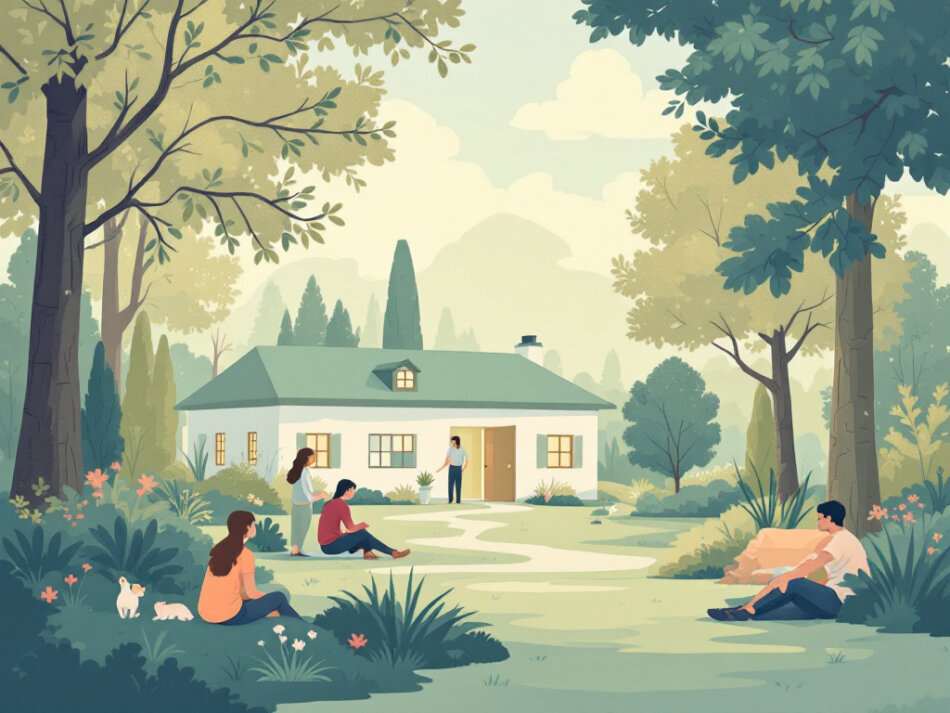Understanding outdoor therapy
Outdoor therapy and adventure programs for teens immerse your child in nature-driven activities that promote emotional regulation, self-confidence, and stronger communication skills. If your teen struggles to open up in a traditional talk therapy setting, you can explore wilderness therapy, adventure therapy, equine therapy, and therapeutic recreation as part of a holistic mental health program for teens. Many of these experiential approaches work alongside licensed clinicians, and are often covered by insurance, making them accessible as you guide your teen toward lasting change.
In this guide, you will learn what outdoor therapy and adventure programs for teens involve, how to assess their holistic benefits, navigate insurance coverage, integrate clinical care, choose the right option, and prepare your teen for a successful experience.
Definition and approach
Outdoor therapy, also called outdoor behavioral healthcare, uses natural settings—forests, rivers, mountains—as therapeutic classrooms. Licensed therapists and trained field staff blend clinical interventions with group challenges, skill building, and guided reflection. You’ll often find a screen-free environment that encourages your teen to engage fully in the moment, fostering deeper self-awareness and responsibility.
Key therapeutic elements
- Structured nature activities, such as hiking, camping, or rock climbing
- Group processing sessions and individual therapy check-ins
- Skill development in leadership, problem solving, and self-regulation
- Emphasis on whole-body health, including nutrition, sleep, and physical fitness
- Family programming that reinforces growth and communication back home
Exploring program models
Choosing among outdoor therapy and adventure programs for teens begins with understanding different models. Each approach has its own structure, therapeutic focus, and setting.
Wilderness therapy
Wilderness therapy programs immerse teens in remote natural landscapes for multi-week expeditions or nomadic experiences. They combine survival skills training, group challenges, and clinical support.
Blue Ridge Wilderness
Blue Ridge Therapeutic Wilderness in North Georgia offers nature-based therapy for ages 12–28. A high staff-to-student ratio (3:1 or lower) ensures individualized support. Family sessions and holistic clinical treatment reinforce long-term growth [1].
RedCliff Ascent
Since 1993, RedCliff Ascent in Utah has paired licensed therapists with trained field guides. It boasts a 94 percent completion rate compared to 37 percent in traditional therapy, attributed to its safety standards and use of nature as a healing environment [2].
Adventure therapy
Adventure therapy blends outdoor challenge courses with therapeutic processing. Teens return regularly to basecamp for individual and group counseling.
Aspiro Adventure
Aspiro Adventure uses activities like mountain biking, rock climbing, and river rafting to create “flow” experiences. A 2004 follow-up found 83 percent of clients doing better two to three years post-program, with 86 percent in school or work [3].
Evoke Cascades
Evoke Cascades in Oregon applies a full-immersion model, removing teens from familiar surroundings for several weeks. While some participants report profound growth, others describe feelings of isolation and harsh conditions, highlighting the need for trauma-informed safeguards [4].
Equine therapy
Equine-assisted therapy harnesses the natural bond between horses and humans to foster trust, emotional awareness, and nonverbal communication. Sessions often combine groundwork, riding, and reflective discussion to improve self-esteem and relational skills [5].
Therapeutic recreation
Therapeutic recreation uses structured leisure activities—canoeing, ropes courses, or team sports—to address behavioral and emotional challenges. It can serve as a step-down from wilderness therapy or a standalone outpatient option, supporting social skills and healthy risk-taking [6].
Assessing holistic benefits
Outdoor therapy and adventure programs for teens deliver a range of interconnected benefits that support your child’s overall mental health.
Emotional regulation
Exposure to challenging situations in nature teaches teens to notice and manage strong emotions. Programs often include mindfulness practices to help your teen track triggers and apply coping strategies in real time. Many participants graduate with increased self-awareness and tools to calm anxiety when they return home [7].
Confidence and resilience
Mastering outdoor skills—like building a fire or navigating terrain—boosts self-efficacy and resilience. Each success reinforces a positive self-image, encouraging your teen to tackle academic or social challenges with renewed confidence.
Communication skills
Group-based challenges require clear communication, active listening, and constructive feedback. Facilitated processing sessions help your teen translate these skills into everyday relationships, improving teamwork and empathy.
Navigating insurance coverage
Many families worry about out-of-pocket costs. Fortunately, several outdoor therapy options accept insurance, reducing financial barriers.
Insurance landscape
Your teen’s mental health benefits may cover parts of outdoor therapy under “behavioral health” or “residential treatment.” Verify whether your plan includes out-of-network coverage, case management support, or prior-authorization requirements.
Covered program types
- Wilderness therapy and adventure therapy
- Equine-assisted and experiential therapies
- Therapeutic recreation and holistic residential programs
Look for programs listed under experiential modalities to find providers that accept your coverage [8].
How to verify benefits
- Review your insurance summary of benefits, focusing on mental health and residential care sections
- Contact member services to confirm coverage levels and authorization steps
- Ask the program’s admissions team for CPT codes and typical billing practices
Integrating clinical therapy
Outdoor programs achieve best results when they complement ongoing clinical support and holistic modalities.
Family involvement
Most programs include family workshops, impact letters, and weekend visits. These sessions help your household adopt shared values, set healthy boundaries, and maintain progress long term.
Collaboration with clinicians
Licensed therapists often coordinate with your teen’s outpatient counselor or psychiatrist. This may include remote case consultations, shared treatment plans, and transition meetings to ensure continuity of care [9].
Specialized modalities
Outdoor therapy frequently integrates expressive, mindfulness, and creative techniques:
- Art and music therapy to explore emotions visually and sonically [10]
- Experiential DBT and mindfulness to build distress tolerance [11]
- Mindfulness and yoga sessions in natural settings [12]
- Equine and expressive activities that blend movement, metaphor, and somatic awareness [13]
- Expressive methods for teens who struggle to articulate feelings verbally [14]
- Trauma-informed art and movement exercises [15]
Choosing the right program
Selecting a safe, accredited program is essential for your teen’s well-being and successful outcomes.
Accreditation and safety standards
Opt for providers accredited by organizations like the Association for Experiential Education, The Joint Commission, or the Outdoor Behavioral Healthcare Council. These bodies enforce rigorous safety and clinical guidelines. Be aware of reports of harsh practices or neglect in unlicensed facilities [16].
Staff qualifications and ratios
Look for a high ratio of staff to participants—ideally 1:3 or lower—to ensure personalized attention. Staff should include licensed mental health professionals, certified wilderness guides, and medical personnel.
Duration and intensity
Programs range from weekend retreats to 20-day expeditions or longer residential stays. Longer durations often yield stronger improvements in social skills, motivation, and academic engagement [3]. Match the intensity to your teen’s readiness and treatment goals.
Preparing your teen
A successful outdoor therapy experience begins with clear communication and practical planning.
Setting expectations
Discuss program rules, goals, and challenges beforehand. Emphasize teamwork, honesty, and openness to growth.
Essential packing list
- Weather-appropriate clothing and sturdy footwear
- Personal hygiene items and any medications
- Small journal or notebook for reflections
- Reusable water bottle and snacks if permitted
- Optional comfort items (photos, small keepsakes)
Pre-program orientation
Most providers conduct a thorough intake assessment, medical review, and family orientation call. Use this opportunity to address any concerns and clarify logistics [17].
Evaluating program outcomes
Tracking progress helps you and your teen appreciate gains and plan for ongoing support.
Success metrics
- Completion and graduation rates
- Improvements in emotional regulation and resilience
- Enhanced social skills and academic engagement
- Participant and parent satisfaction scores (95 percent of teens found wilderness therapy beneficial in one study [18])
Long-term support and follow-up
Quality programs offer alumni networks, booster sessions, and referrals to outpatient or residential care as needed [19]. Ongoing coaching helps your teen integrate lessons learned in nature into daily life and sustain positive change.
By understanding these components—program models, holistic benefits, insurance coverage, clinical integration, and outcome evaluation—you can make an informed choice in selecting an outdoor therapy and adventure program that supports your teen’s unique journey toward emotional health and personal growth.
References
- (Blue Ridge Wilderness)
- (RedCliff Ascent)
- (PMC)
- (Undark)
- (equine therapy for adolescents)
- (therapeutic recreation for teens with emotional challenges)
- (holistic emotional regulation program for teens)
- (experiential therapy that accepts insurance, teen holistic therapy that accepts insurance)
- (holistic mental health program for teens)
- (art and music therapy for teens)
- (experiential dbt and mindfulness for adolescents)
- (mindfulness and yoga therapy for teenagers)
- (therapy program using equine and expressive modalities)
- (therapy for teens who struggle to express emotions, expressive therapy for teens)
- (therapy for teen trauma through art and movement)
- (The Guardian)
- (holistic therapy for teen stress and self-awareness)
- (Newport Academy)
- (integrative experiential therapy for teens, teen holistic therapy program)











